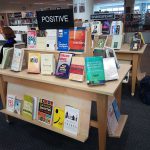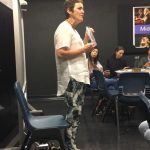Background:
Six teachers (Mr. Alan Cheng, Ms. Cheung Chor Yin, Mr. Jimmy Ho, Mr. Li Kin Man, Ms. Sham Lui and Mr. Andrew Stevenson) from our school attended a 2-day conference “Positive Schools: Bringing Positive Education Alive” between 25th – 26th November 2016 at The Centre for International Education, United World College of South East Asia (East Campus) in Singapore. Being one of the highest-regarded well-being and positive education conferences in the world, it naturally attracted some of the leading scholars in the field as well as hundreds of teachers keen to know more about positive education.
During the two days, 10 keynote speeches were given by specialists in the field including Dr Michael Carr-Gregg (adolescent psychologist), Janet Etty-Leal (mindfulness in schools), Thea O’connor (positive body image), and Dr Kerry Howells (gratitude in education) just to name a few. The topics ranged from well-being to brain science, supporting anxious students to creating a positive school. It was also an honour to have Mr. Justin Robinson (Geelong Grammar School) share strategies for creating positive relationships at school. The selected topics were explored further through keynote discussions and parallel workshops where teachers had a chance to interact with fellow educators from around the world. Teachers left with minds full of intriguing possibilities in making students’ and teachers’ well-being a top priority.
Here are some of our teachers’ thoughts after attending the conference:
Mr. Alan Cheng
For positive education to work and become the fabric of our school, we must begin with teachers first. How teachers feel (gratitude or resentment) will flow down to the students. We need to embrace and encourage teachers to voice how they feel. It might be a bit uncomfortable to begin with, particularly for teachers on the receiving end of the feedback, but it’s better for teachers to have the courage to say how they feel than for them to keep it in and allow the feeling of resentment to build.
Another reason why teachers are so important is simply that students are more likely to learn from a teacher they “like”. This relationship hinges on how the teacher feels and how much time and effort the teacher is willing to invest in building such a relationship. At the end of the day, you can’t have students’ well-being without teachers’ well-being.
Something often neglected is intentional relationship planning. Do we know students beyond their student numbers and names? It goes back to idea of relationships. Do students care more about the curriculum being taught or the relationship they build with teachers? Which one do we spend more time on planning?
Parents’ influence at home is undeniable and perhaps even greater than our role as a teacher. How can we spread positive education to parents too?
Ms. Cheung Chor Yin
“Mindfulness is both a form of meditation and a way of living. As a form of meditation it might initially be thought of as a way of providing welcome respite from this increasingly frenetic and fast-paced modern world, but to see it as only that greatly limits the usefulness and scope of mindfulness.” — Dr. Craig Hassed
I found the practice of mindfulness and the way of meditation is very important to our daily life, to think, to reflect, to relieve and to thank. Eg, in Chinese teaching (curriculum), we teach students the ancient Chinese value of Taoism in senior form, which is a way similar to mindfulness practice. It’s a bit difficult for students to understand which it needs teacher’s guidance for explanation. Or maybe we can have little classroom activities teaching when we are teaching students related topics.
Mr. Jimmy Ho
Gratitude has a tremendous effect on building a positive environment. But to cultivate the sense of gratitude, there are two things we must address first, resentment and recognition.
Resentment cannot coexist with gratitude. Therefore, we have to properly address the resentment of the people. Resentment comes in different forms that we are not unfamiliar with: complaining, gossiping and even direct conflict. There are proper and proactive ways to express resentment and both teachers and students can learn these to avoid resentment building up.
Recognition means knowing. It is about both knowing the person as well as getting known. This “knowing” is crucial in building relationship and can amplify the power of gratitude. The person will also feel the appreciation is authentic.
Ms. Sham Lui
Build up the routine of the teaching
1 something interesting,
2 something to memorize,
3 something to ask,
4 something to practice
Enhancement of gratitude
1 including reading and writing of the theme
(感恩,感動,感受――生命的美好)
2 encourage students to express their gratitude towards teachers and parents
3 training of critical thinking-warm, cold and strong opinions.
Mr. Andrew Stevenson
For some time I have personally been wrestling with the idea of what constitutes a ‘professional relationship’ with students. From my teacher training in the UK I had the idea of maintaining professional distance with students impressed upon me very strongly. This was seen as a highly important safeguard for teachers and in many ways made it difficult to develop meaningful connections with students. This approach can cause a disconnect with the ideas of positive education which highlights the importance of establishing personal connections with your students in order to strengthen learning. I would like to establish clearer guidelines on teacher / student relationships in order to both safeguard teachers and allow for the flexibility for positive relationships to develop.
I strongly believe in the philosophy and practice of positive education – it aligns with my personality and my ethics. Not all teachers, however, necessarily feel the same way. People practice education in different ways, in the classroom and out. This seems like a good thing, to allow for a freedom of teaching style / approach but I fear it may be counter-intuitive if we truly want to make the school a more positive learning environment. The values of teachers are passed down to the students through lessons, CCA’s student groups, sports teams etc. And if some teachers are not embracing positive values, then this actually significantly weakens the position of those that are. In order for positive education to really take hold, it needs to be truly adopted as a whole school approach.











